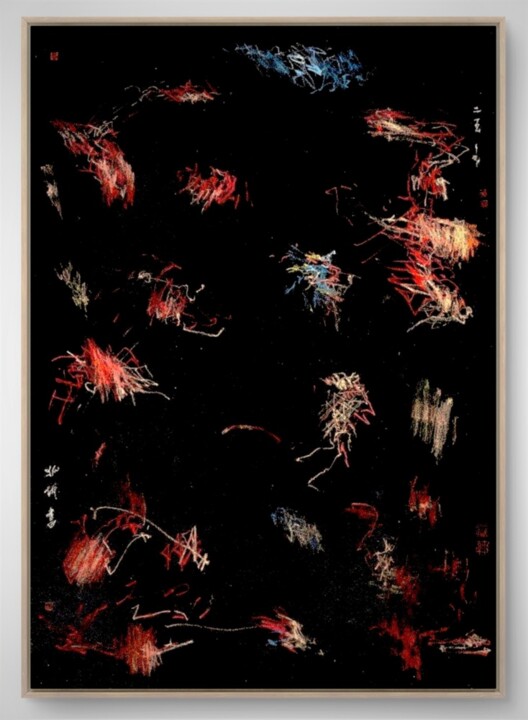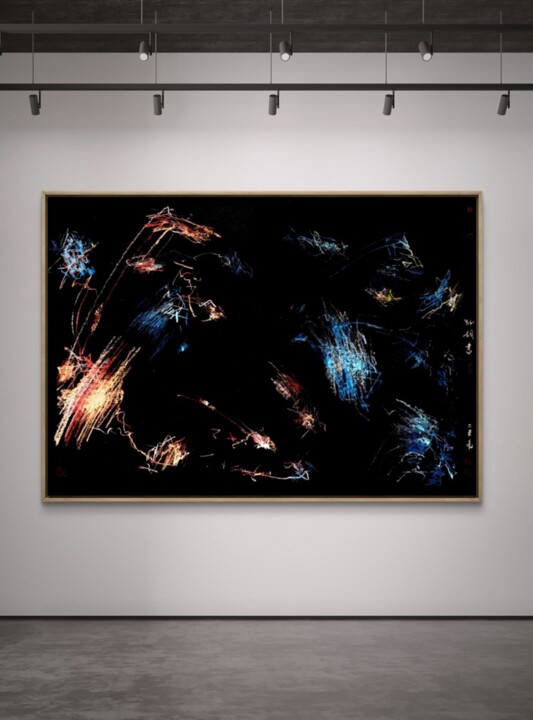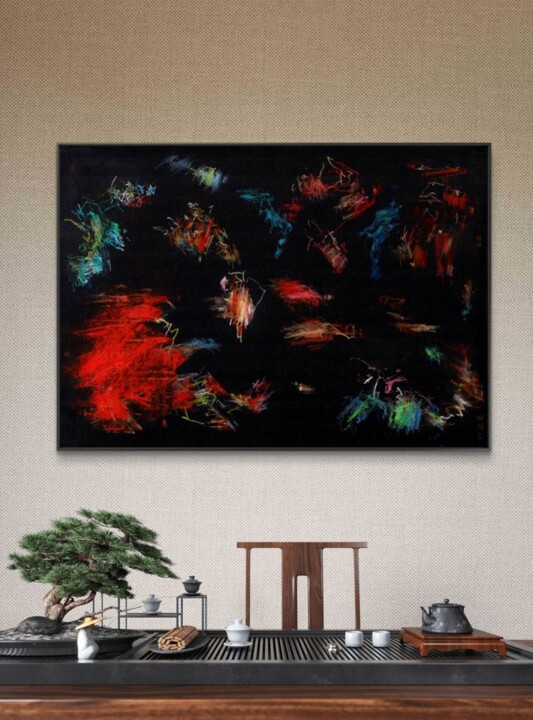Welcome, art enthusiasts, to an intimate look at my latest significant body of work: the "Nothingness in Color" series. This collection represents a profound evolution in my artistic practice, stemming from years of exploring the essence of form and meaning through a minimalist lens.
The Genesis of Nothingness: From Monochrome to Chromatic Depth
My artistic journey began with a deep immersion in monochrome, a deliberate stripping away of all but the most fundamental elements. This foundation laid the groundwork for the "Nothingness in Color" series, which courageously, yet gradually, embraced the spectrum. At its core, my minimalist approach remains steadfast, deeply interwoven with the timeless philosophies of Zen painting and Daoism. These ancient wisdoms continue to guide my hand, reminding me that profound meaning can reside in simplicity, and that the void itself is a fertile ground for creation.
The Art of Omission and the Paradox of Presence
In "Nothingness in Color," I returned to the challenging principle of omission. It’s an intriguing paradox: how do you remove elements when there's already so little left? Yet, within this extreme reduction, the absolute essential—the very heartbeat of my artistic signature—emerges: contrasts. This series is a testament to the powerful interplay of opposing forces, a dance of:
Movement and Stillness
Power and Softness
Darkness and Light
While these paintings might appear deceptively simple, their creation is often profoundly challenging. My process involves navigating numerous pitfalls: avoiding the merely "pleasing," resisting cheap effects, and striving to impress through nuanced color alone. My constant goal is to blur the line between the concrete and the abstract, to discover that delicate balance where the work resonates most authentically. This continuous search often feels like a precarious balancing act, but it's precisely where the true essence of the work takes form.

Echoes of Emptiness, Whispers of Light
From the "Nothingness in Color" series, this piece embodies a minimalist dialogue between presence and absence. Luminous strokes of blue, green, and subtle gold emerge from the deep void, akin to "whispers of light" animating the "echoes of emptiness." Inspired by Zen and Daoist principles, it explores the profound interplay of light and shadow, inviting contemplation on the dynamic contrasts that define existence.
Adding to "Nothingness": The Creative Imperative
As artists practicing omission, we inevitably reach a limit—a zenith, much like in life itself. When we choose to leave something out, we must then fill the resulting "emptiness" with something else. This could be a single ray of light, a splash of color, or a precise line. Crucially, these additions must always remain subservient to the overarching concept of nothingness, enhancing it rather than overwhelming it.
In this next phase, I consciously chose to add rather than solely omit. This presents a unique challenge: how to introduce more elements without compromising the fundamental idea of nothingness, or losing the dynamic flow and the essential interplay of opposing poles.

Meditations on Absence
This piece from the "Nothingness in Color" series delves into the profound concept of absence, a core tenet of Zen and Daoist philosophy. Against a vast, dark ground, fragmented bursts of color – primarily vibrant reds and blues – appear as fleeting thoughts or echoes. Each luminous mark serves as a point of contemplation, inviting the viewer to meditate on the power of the unsaid, the unseen, and the dynamic tension between the void and the brief, energetic moments of presence.
Diving Deeper: Microcosm, Macrocosm, and Musical Resonance
The painting "Essence of Flow" directly addresses this challenge of adding while preserving the core. It strives to embody this claim while also introducing the concept of microcosm versus macrocosm, hinting at the spherical nature of these unseen forces within the minimalist field.
My piece, "Flickers of Being," was originally conceived as the singular "State of the Art 2025." However, its subtleties don't always translate effectively on screen, prompting the decision to present the entire series instead. My intention for each of these "flickers" was to imbue them with meaning, without being overly specific. More importantly, I aimed to create a dialogue between all the individual elements—a constant endeavor in my work. This painting, like others in the series, carries a strong affinity with the music of Anton von Webern, whose post-romantic, minimalist approach deeply resonates with my artistic heart.

Whispers of Genesis
Part of the "Nothingness in Color" series, "Whispers of Genesis" explores the profound moment of creation emerging from the void, echoing the tenets of Daoist philosophy. Dynamic lines and luminous colors — notably blues, reds, and golden earth tones — subtly coalesce against the deep black, suggesting nascent forms and directional energy. This painting captures the delicate balance between the formless and the emergent, portraying a quiet, elemental beginning where presence softly unfurls from absence.
Embracing the Full Spectrum: The Challenge of "Heart of the Silence"
"Heart of the Silence" takes this exploration a step further, opening up to a full color palette. It's often simpler to achieve a harmonious expression when working with fewer colors. Each additional color, however, introduces a new layer of "excitement," making the pursuit of meditative expression, tranquility, and a sense of the eternal considerably more difficult. Yet, this challenge is precisely where the deeper conversation of "Nothingness in Color" truly begins.

Heart of the Silence
From the "Nothingness in Color" series, "Heart of the Silence" delves into the profound quietude that can emerge even within a full chromatic palette. Here, vibrant hues, anchored by a commanding red presence, bloom against the deep black, defying the inherent "excitement" of a broader spectrum. This piece embodies the challenge of achieving meditative expression and tranquility amidst increased complexity, revealing the harmonious and eternal core within the dynamic interplay of color and the infinite void.
My Artistic Signature: What Makes "Nothingness in Color" Unique
Even a president finds reason to praise himself, so as an artist, I feel entitled to share why I believe this "State of the Art 2025" series truly represents a pinnacle in my work.
Firstly, I've dedicated myself to developing a distinct style and, indeed, my own unique technique. Many artists spend their entire careers striving for a recognizable artistic signature—creating works immediately attributable to them. This pursuit is as challenging in visual art as it is in any other creative discipline.
Furthermore, this current series seamlessly integrates with my work from recent years. Its foundational ideas remain consistent, rooted deeply in Daoist and Zen philosophies. While simply replicating the Old Masters holds little purpose, I find it essential to cultivate these profound philosophical concepts and reinterpret them within a contemporary context. For instance, modern quantum physics, with its confirmation of entanglement, echoes principles Zen embraced over a century ago. In my painting, I strive to incorporate this aspect of interconnectedness—the entanglement of lines, dots, and forms.
This endeavor has led me to forge a style that masterfully blends Western and Far Eastern artistic ideas. Far fewer painters achieve this synthesis than one might imagine. Many still recall the groundbreaking collaboration between Ravi Shankar and Yehudi Menuhin; their "West Meets East" album remains a musical milestone, a parallel to the artistic bridge I aim to build.
I could continue this list, but that's quite enough self-congratulation :)